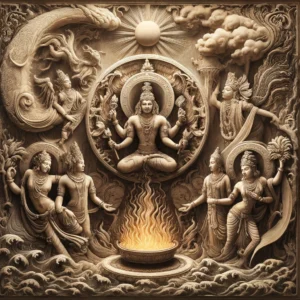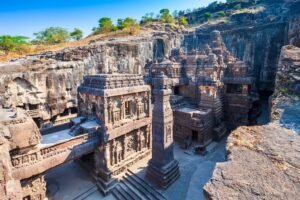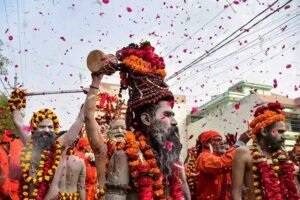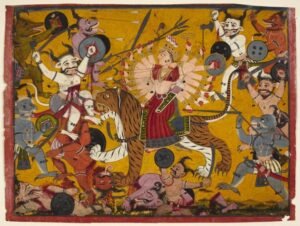Introduction
Adi Shankaracharya, one of the most remarkable philosophers and spiritual luminaries in the history of India, left an indelible mark on Hinduism and its philosophical landscape. Born around 788 CE in the tranquil village of Kaladi, located in present-day Kerala, India, his life and teachings continue to inspire millions worldwide.
While there exists some debate regarding his exact birth year, his intellectual brilliance and profound spiritual insights are undeniable. From his earliest years, it was evident that Adi Shankaracharya possessed an extraordinary intellect and a deep-seated interest in matters of spirituality.
Orphaned by the untimely demise of his father, he was lovingly raised by his mother, Aryamba. At the tender age of eight, Shankara expressed his fervent desire to renounce worldly life and devote himself to the study of the Vedas, the ancient scriptures that underpin Hindu philosophy and spirituality.
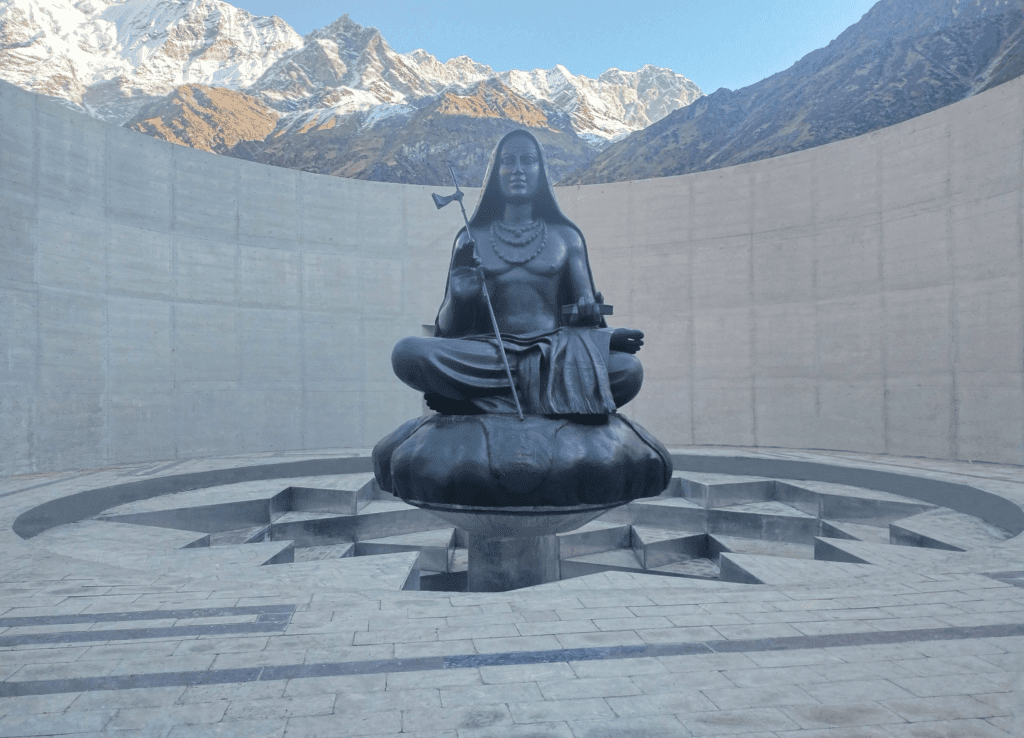
Although initially hesitant, his mother eventually granted her consent, thus setting the stage for a transformative spiritual journey. Under the mentorship of the venerable Govinda Bhagavatpada, a revered teacher of Advaita Vedanta, young Shankara embarked on an odyssey of profound learning and self-discovery.
His deep immersion in the scriptures, particularly Advaita Vedanta, which posits the non-dual nature of reality, would come to define his life’s work and legacy.
Philosophical Contribution and Teachings of Adi Shankaracharya
Adi Shankaracharya’s most profound contribution lies in the realm of Advaita Vedanta, a philosophical school that expounds the concept of non-duality (advaita). According to this doctrine, the ultimate reality, known as Brahman, transcends all attributes, forms, and dualities.
Shankara elucidated this philosophy through extensive commentaries on ancient Vedantic texts, including the Upanishads, Bhagavad Gita, and Brahma Sutras. His life was punctuated by extensive journeys across the Indian subcontinent, where he engaged in spirited debates with scholars representing diverse traditions.
Shankara ardently advocated for renunciation (sannyasa) and underscored the importance of spiritual realization through meditation and self-inquiry.
Advaita Vedanta:
Shankara’s most enduring contribution to Hindu philosophy is his interpretation and propagation of Advaita Vedanta. According to his teachings, the material world and individual selves (atman) are illusory, and the true self (atman) is identical with the ultimate reality (Brahman).
Concept of Maya:
Central to Shankara’s philosophy is the concept of Maya, described as the cosmic illusion that veils the true nature of reality. Maya creates the perception of duality and multiplicity in the world, leading individuals to believe in the existence of separate entities.
The Importance of Self-Realization:
Shankara stressed the paramount importance of self-realization (atma-jnana) as the ultimate goal of human life. He believed that by realizing one’s true nature as Brahman, individuals could attain liberation (moksha) from the cycle of birth and death (samsara).
Interpretation of Scriptures:
Shankara’s extensive commentaries on the Upanishads, Bhagavad Gita, and Brahma Sutras provide his unique perspective on these sacred texts. His commentaries are revered for their clarity and profound insights.
Contribution to Hinduism
Adi Shankaracharya’s contributions to Hinduism are multifaceted and continue to shape the way people perceive and practice the religion.
Unity in Diversity:
Shankara’s teachings emphasized the unity of all beings and the underlying oneness of all religious paths. He promoted religious tolerance and believed that various deities and rituals were different manifestations of the same ultimate reality.
Preservation of Vedic Knowledge:
At a time when the Vedic tradition faced challenges and fragmentation, Shankara played a vital role in preserving and revitalizing Vedic knowledge. His commentaries and writings helped clarify the teachings of the Vedas and inspired a revival of Vedic studies.
Establishment of Monastic Orders:
Shankara founded four monastic orders (mathas) in different parts of India, each with its presiding deity and head. These mathas continue to play a significant role in the propagation of Advaita Vedanta and the preservation of Hindu traditions.
Reconciliation of Contradictions:
Shankara’s philosophical system reconciled apparent contradictions within Hinduism, such as the tension between ritualistic practices and the pursuit of spiritual knowledge. He advocated for the harmonious coexistence of these aspects, emphasizing that both were valuable in their own right.
Establishment of Mathas by Adi Shankaracharya
Adi Shankaracharya’s unwavering commitment to preserving and propagating Advaita Vedanta led him to establish four monastic centers, known as “mathas,” strategically located in the cardinal directions of India.
These mathas serve as enduring symbols of his legacy and continue to play pivotal roles in the propagation of his teachings:
- Badrinath Matha (North): Nestled in the pristine environs of Badrinath, this matha in the northern reaches of India stands as a beacon of spiritual enlightenment. To reach Badrinath, one can undertake a journey by road, rail, or air, with the nearest airport being Jolly Grant Airport in Dehradun.
- Puri Matha (East): Situated in the sacred city of Puri on the eastern coast, this matha carries forward Shankaracharya’s teachings and devotion to the divine. To reach Puri, one can travel by train to Puri Railway Station or by air to Biju Patnaik International Airport in Bhubaneswar.
- Dwarka Matha (West): In the historic city of Dwarka on the western coast, this matha upholds the tradition of Advaita Vedanta, preserving the philosophy’s profound wisdom. Dwarka can be accessed by train or through Jamnagar Airport.
- Sringeri Matha (South): Nestled in the southern part of India, the Sringeri matha continues to be a vital center for the study and practice of Advaita Vedanta. The closest airport is Mangalore International Airport, and the matha is accessible by road and rail.
Revival Movement
Adi Shankaracharya’s lifetime coincided with a period of intellectual and religious ferment in India. The country grappled with a multitude of religious sects, divergent interpretations of scriptures, and philosophical confusion. In response, Shankara embarked on a mission to unify and revitalize Hinduism. His revival movement comprised several key elements:
Reinterpretation of Scriptures:
Shankara’s commentaries on the Upanishads and other sacred texts clarified their philosophical and spiritual significance. He aimed to restore the true essence of these scriptures, free from distortions and misunderstandings.
Establishment of Monastic Centers:
The four mathas founded by Shankara became centers of learning and spirituality. Monks from these mathas disseminated his teachings and contributed to the preservation of Hindu traditions.
Debates and Discourses:
Shankara engaged in philosophical debates with scholars from various religious traditions, including Buddhism and Jainism. These debates helped clarify the distinctions between different philosophies and strengthened the foundations of Advaita Vedanta.
Bhaja Govindam
Beyond his scholarly pursuits, Shankaracharya was a prolific composer of devotional hymns and poems. One of his most cherished compositions is the “Bhaja Govindam,” a profound devotional work that emphasizes the ephemeral nature of life and the imperative of unwavering devotion to the divine. This timeless composition serves as a source of inspiration and contemplation for countless devotees.
Commentaries by Adi Shankaracharya
Shankaracharya’s commentaries on various Hindu scriptures, particularly those that expound Advaita Vedanta interpretations of the Vedas, remain foundational to the study of Hindu philosophy and spirituality. His works continue to shape the understanding of these ancient texts, serving as guiding lights for scholars and spiritual seekers.
Impact and Legacy
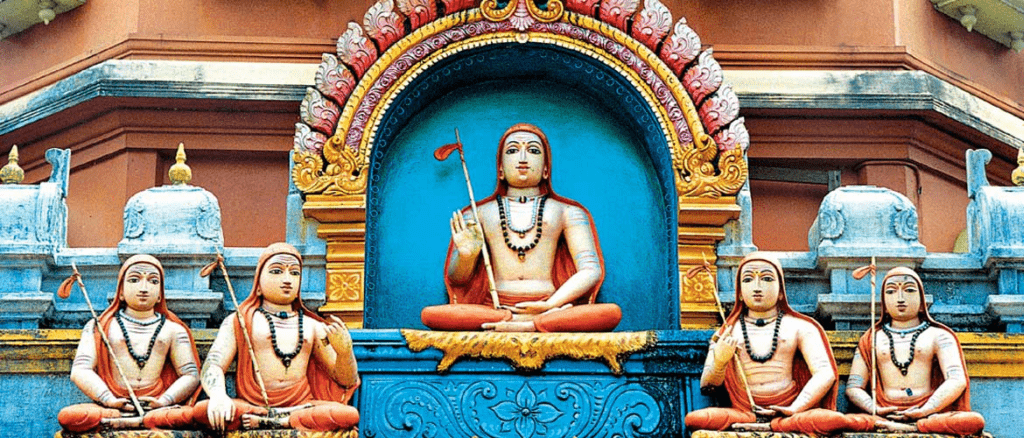
Adi Shankaracharya’s impact on Hinduism and Indian philosophy is immeasurable. His contributions and legacy endure in various ways:
Advaita Vedanta Dominance:
Shankara’s Advaita Vedanta remains a dominant and influential philosophical school within Hinduism. It has profoundly influenced the thought processes of countless seekers and scholars over the centuries.
Philosophical Unity:
Shankara’s teachings provided a philosophical framework that reconciled many diverse schools of thought within Hinduism. This unity has helped maintain the cohesiveness of Hindu religious and philosophical traditions.
Revival of Vedic Tradition:
Shankara’s efforts to clarify and promote Vedic knowledge played a pivotal role in the resurgence of interest in the Vedas and other ancient scriptures.
Adi Shankaracharya’s Towering Legacy:
Temples Dedicated to Him Adi Shankaracharya’s enduring legacy is celebrated not only through his teachings but also through temples dedicated to him across India. These temples serve as places of devotion and pilgrimage for his followers and admirers. Here are some prominent temples dedicated to Adi Shankaracharya:
- Adi Shankaracharya Temple, Kaladi: Located in his birthplace, Kaladi, this temple is dedicated to Adi Shankaracharya. It is a place of pilgrimage and reflection, where devotees can pay their respects to the philosopher. Kaladi is situated in the Ernakulam district of Kerala and is easily accessible by road.
- Adi Shankaracharya Temple, Sringeri: The Sringeri matha, founded by Adi Shankaracharya, houses a temple dedicated to him. This temple is located in the picturesque town of Sringeri in Karnataka. Devotees can reach Sringeri by road or by taking a train to the nearby town of Shimoga.
- Kanchi Kamakoti Peetham, Kanchipuram: While not a temple dedicated solely to Adi Shankaracharya, the Kanchi Kamakoti Peetham in Kanchipuram holds immense significance in the Advaita tradition. It is the seat of the Kanchi Shankaracharya and a revered institution for Advaita Vedanta. Kanchipuram can be reached by road from Chennai, the capital of Tamil Nadu.
- Adi Shankaracharya Temple, Dwarka: Dwarka, located in Gujarat, houses a temple dedicated to Adi Shankaracharya. Devotees can visit this temple after exploring the historic city of Dwarka and its renowned Dwarkadhish Temple. Dwarka is accessible by road and has a railway station.
- Adi Shankaracharya Temple, Badrinath: The Badrinath matha, established by Adi Shankaracharya, is a significant pilgrimage site for his followers. It is located in the sacred town of Badrinath in the Himalayan region of Uttarakhand. Badrinath can be reached by road, and the nearest airport is Jolly Grant Airport in Dehradun.
- Adi Shankaracharya Temple, Puri: While Puri is primarily known for the Jagannath Temple, it also has a temple dedicated to Adi Shankaracharya, reflecting his enduring influence. Puri is well-connected by road and rail, with Bhubaneswar’s airport being the nearest option for air travel. These temples not only serve as places of worship but also as reminders of Adi Shankaracharya’s profound impact on Hinduism and the philosophical legacy he left behind.
The Monumental ‘Statue of Oneness’ in Omkareshwar
On September 21, Madhya Pradesh Chief Minister Shivraj Singh Chouhan unveiled a monumental 108-foot statue of Adi Shankaracharya in the sacred town of Omkareshwar. This colossal sculpture, known as the “Ekatmata Ki Pratima” or “Statue of Oneness,” stands as a profound tribute to the enduring legacy and profound teachings of Adi Shankaracharya.
The statue project, conceptualized six years ago, is situated atop the picturesque Mandhata hill, offering breathtaking views of the Narmada River in the Khandwa district of Madhya Pradesh.
This remarkable cultural endeavor celebrates not only the life and philosophy of Adi Shankaracharya but also commemorates his seminal work, the commentary on ‘Brahmasutrabhasya,’ a foundational text of the Vedanta school of Hinduism that emphasizes the concept of Oneness.
The statue is poised to become a significant cultural and spiritual landmark in India, reflecting the state’s commitment to preserving its rich cultural and spiritual heritage. It serves as a reminder of the profound impact Adi Shankaracharya had on shaping the philosophical and spiritual landscape of India.
Continued Influence
Adi Shankaracharya’s teachings resonate through the annals of Hinduism. He unified diverse sects and schools of thought within the religion, fostering a cohesive philosophical framework. His philosophy of non-duality and the unity of the individual soul (Atman) with the ultimate reality (Brahman) continues to inspire religious and philosophical discourse in India and beyond.
His ideas have gained recognition and followers worldwide, contributing to the global spread of Hindu philosophy. Adi Shankaracharya, the philosopher and theologian from Kerala, left an enduring legacy that transcends time and borders.
His profound wisdom, devotion to Advaita Vedanta, tireless efforts to disseminate spiritual truths, and the establishment of mathas continue to influence and enrich the tapestry of Indian civilization. As we reflect on his life and teachings, we honor a luminary who illuminated the path to spiritual realization for generations to come.

